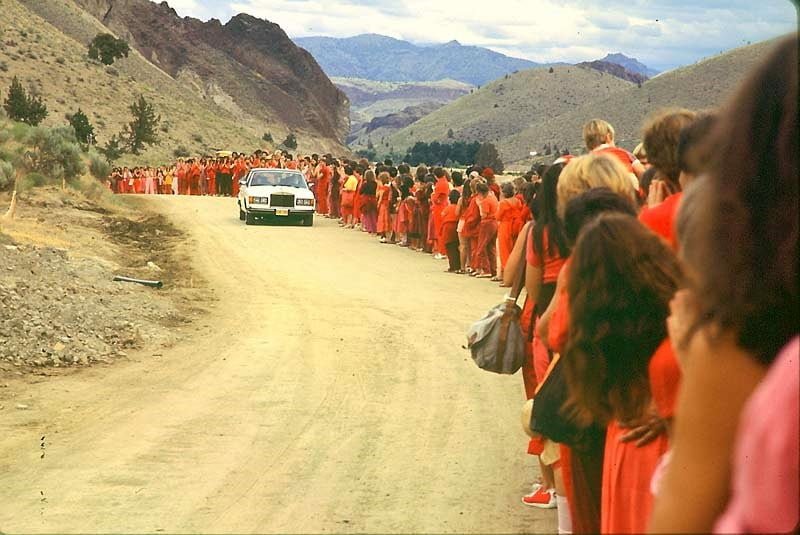
Have you ever hear of Osho aka Rajneesh, a man who’s teaching are still being used today by people to bring peace, devotion and basically a path to live life.
Born Chandra Mohan Jain in 1931 in the small Indian town of Kuchwada, Osho would go on to become one of the most influential spiritual leaders of the 20th century. His life journey, marked by profound introspection and an iconoclastic approach to spirituality, would captivate followers worldwide while also drawing intense scrutiny and controversy.
Early Life and Philosophical Awakening
From a young age, Osho displayed an insatiable thirst for knowledge and a propensity to question established norms. This intellectual curiosity led him to study philosophy at the University of Sagar, where he experienced a profound existential crisis.
Grappling with the nature of existence and the human condition, Osho’s philosophical inquiries laid the groundwork for his later teachings, which would emphasize the importance of self-awareness and the rejection of societal conventions.
After completing his education, Osho began his career as a professor of philosophy at Jabalpur University. His lectures, renowned for their incisive criticism of traditional religious and social structures, garnered significant attention.
However, Osho soon realized that academic life restricted the full expression of his burgeoning spiritual insights. In the early 1960s, he made the decision to renounce conventional living, dedicating himself to the pursuit of enlightenment and sharing his vision of a liberated, meditative existence with the world.
The Rise of a Spiritual Leader
Osho’s journey towards becoming a spiritual leader was marked by several key milestones. In 1964, he began conducting meditation camps, where he introduced his unique techniques for achieving higher states of consciousness.
These camps attracted a growing number of followers, who were drawn to his radical ideas and charismatic presence. By 1974, Osho had established his first ashram in Pune, India, which quickly became a thriving center for spiritual seekers from around the globe.
The establishment of his ashram and the creation of various spiritual communes were pivotal moments in Osho’s life.
These communities provided a space for individuals to explore his teachings, which integrated elements of Eastern mysticism, Western philosophy, and modern psychology. Over time, Osho’s influence grew, and his teachings continue to inspire and challenge individuals to this day.
Osho’s Teachings: A Unique Blend of Spirituality
Osho’s philosophical approach blended Eastern spiritual traditions with Western philosophies, creating a unique and multifaceted spiritual framework. At the core of his teachings was an emphasis on meditation, mindfulness, and living in total awareness.
Osho introduced various dynamic meditation techniques designed to help individuals release their inner tensions and achieve a state of pure consciousness.
Mindfulness, another key aspect of Osho’s teachings, promoted a continuous, moment-to-moment awareness of one’s actions, thoughts, and environment.
This practice, he believed, could enable individuals to transcend the limitations of their conditioned minds and attain a state of liberation.
Osho also addressed topics such as love and sexuality, often challenging conventional beliefs and societal taboos. He argued that love should be free from attachments and possessiveness, advocating for a pure, unconditional love that allows for personal growth and freedom.
Regarding sexuality, Osho encouraged an open and liberated approach, viewing it as a natural and essential aspect of human existence.

Global Reach and the Rajneeshpuram Commune
Osho’s influence soon transcended geographical boundaries, becoming a global phenomenon. His teachings resonated with individuals from diverse cultural and socioeconomic backgrounds, who were drawn to his charismatic persona and the universal relevance of his spiritual framework.
The establishment of the Osho International Meditation Resort in Pune, India, became a crucial center for his teachings and practices. This spiritual haven attracted tens of thousands of followers from around the world, providing a space for profound personal transformation.
Osho’s global reach further expanded with the creation of the Rajneeshpuram commune in Oregon, USA, in the early 1980s. This utopian community, based on his teachings, brought together individuals from various backgrounds, united in their quest for spiritual growth and communal living.
However, the commune’s eventual downfall due to controversies and legal issues would cast a shadow on Osho’s legacy.
Controversies and Criticisms
Osho’s life and teachings were not without controversy. His deportation from the United States in 1985 highlighted the legal and political challenges surrounding his movement, including charges of immigration violations.
Additionally, criminal activities involving his close followers, such as the 1984 bioterror attack in Oregon, further tainted his image.
Internal conflicts within Osho’s communes also emerged as significant issues, with reports of financial scandals and allegations of drug use and hedonistic sexual practices.
These controversies fueled public backlash and criticism, even as Osho’s supporters argued that many accusations were exaggerated or politically motivated.
Enduring Legacy and Ongoing Debate
While his teachings on meditation, mindfulness, and personal freedom continue to inspire and challenge individuals globally, the legal and political entanglements, criminal actions by his followers, and alleged misdeeds within his communities have cast a shadow over his work.
Understanding Osho, therefore, requires a balanced analysis that acknowledges both his visionary spiritual insights and the contentious issues that accompanied his life and movement.
As the debate surrounding his legacy continues, Osho’s impact on the global spiritual landscape remains a subject of ongoing fascination and discussion.
